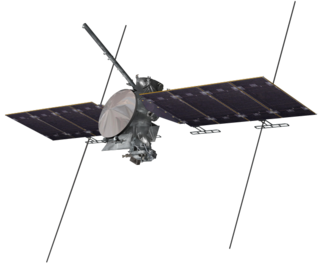Related Research Articles

Space exploration is the use of astronomy and space technology to explore outer space. While the exploration of space is currently carried out mainly by astronomers with telescopes, its physical exploration is conducted both by uncrewed robotic space probes and human spaceflight. Space exploration, like its classical form astronomy, is one of the main sources for space science.

The Jupiter Icy Moons Orbiter (JIMO) was a proposed NASA spacecraft designed to explore the icy moons of Jupiter. The main target was Europa, where an ocean of liquid water may harbor alien life. Ganymede and Callisto, which are now thought to also have liquid, salty oceans beneath their icy surfaces, were also targets of interest for the probe.

The planet Mars has been explored remotely by spacecraft. Probes sent from Earth, beginning in the late 20th century, have yielded a large increase in knowledge about the Martian system, focused primarily on understanding its geology and habitability potential. Engineering interplanetary journeys is complicated and the exploration of Mars has experienced a high failure rate, especially the early attempts. Roughly sixty percent of all spacecraft destined for Mars failed before completing their missions, with some failing before their observations could even begin. Some missions have been met with unexpected success, such as the twin Mars Exploration Rovers, Spirit and Opportunity, which operated for years beyond their specification.

The Japan Aerospace Exploration Agency (JAXA) is the Japanese national air and space agency. Through the merger of three previously independent organizations, JAXA was formed on 1 October 2003. JAXA is responsible for research, technology development and launch of satellites into orbit, and is involved in many more advanced missions such as asteroid exploration and possible human exploration of the Moon. Its motto is One JAXA and its corporate slogan is Explore to Realize.

A lunar lander or Moon lander is a spacecraft designed to land on the surface of the Moon. As of 2024, the Apollo Lunar Module is the only lunar lander to have ever been used in human spaceflight, completing six lunar landings from 1969 to 1972 during the United States' Apollo Program. Several robotic landers have reached the surface, and some have returned samples to Earth.

Time History of Events and Macroscale Interactions during Substorms (THEMIS) mission began in February 2007 as a constellation of five NASA satellites to study energy releases from Earth's magnetosphere known as substorms, magnetic phenomena that intensify auroras near Earth's poles. The name of the mission is an acronym alluding to the Titan Themis.

The following outline is provided as an overview of and topical guide to space exploration.

Europa Clipper is a space probe in development by NASA. Planned for launch in October 2024, the spacecraft is being developed to study the Galilean moon Europa through a series of flybys while in orbit around Jupiter. It is the largest spacecraft NASA has ever developed for a planetary mission.

Psyche is a NASA Discovery Program space mission launched on October 13, 2023 to explore the origin of planetary cores by orbiting and studying the metallic asteroid 16 Psyche beginning in 2029. NASA's Jet Propulsion Laboratory (JPL) manages the project.
The future of space exploration involves both telescopic exploration and the physical exploration of space by robotic spacecraft and human spaceflight.

This article documents expected notable spaceflight events during the 2020s.

The year 2024 is expected to exceed 2023's 223 orbital launches. So far, the year saw the successful first launch of Vulcan Centaur, Gravity-1, and notably the third developmental launch of SpaceX's Starship – IFT-3. Additionally, the final launch of a Delta family rocket occurred in April with a Delta IV Heavy. In May, China launched the Chang'e 6, the first sample return from the far side of the Moon. Following 2020s' trend, it is expected that many more privately-developed launch vehicles will feature a maiden launch in 2024.

Photon is a satellite bus based on Rocket Lab's kick stage.

Shannon Curry is a planetary physicist and the Principal Investigator of the NASA Mars Scout mission MAVEN. Dr. Curry is a researcher at the Laboratory for Atmospheric and Space Physics (LASP) at the University of Colorado Boulder and an Associate Professor in the university's Astrophysics and Planetary Sciences (APS) Department. Prior to this, she served as the Deputy Assistant Director of Planetary Science at the Space Sciences Laboratory at the University of California, Berkeley.

Small Innovative Missions for Planetary Exploration (SIMPLEx) is a planetary exploration program operated by NASA. The program funds small, low-cost spacecraft for stand-alone planetary exploration missions. These spacecraft are intended to launch as secondary payloads on other missions and are riskier than Discovery or New Frontiers missions.
References
- 1 2 Foust, Jeff (25 April 2024). "NASA planning September launch of Mars smallsat mission on first New Glenn". SpaceNews . Retrieved 26 April 2024.
- ↑ Sanders, Robert (2021-08-23). "'Blue' and 'Gold' satellites headed to Mars in 2024". Berkeley News. Retrieved 2023-02-11.
- 1 2 3 4 "NASA – NSSDCA – Spacecraft – Details". NSSDC . NASA . Retrieved 2023-02-11.
 This article incorporates text from this source, which is in the public domain .
This article incorporates text from this source, which is in the public domain . - ↑ Foust, Jeff (13 April 2023). "ESCAPADE confident in planned 2024 New Glenn launch". SpaceNews . Retrieved 14 April 2023.
- ↑ @RocketLab (May 1, 2024). "This spacecraft is going to Mars" (Tweet). Retrieved 9 May 2024– via Twitter.
- ↑ Hatfield, Miles (August 20, 2021). "NASA’s ESCAPADE Mission – Twin Martian Orbiters – Moves Toward Launch," NASA. Retrieved 23 Nov. 2023.
- 1 2 Foust, Jeff (February 20, 2023). "Trials and tribulations of planetary smallsats", The Space Review. Retrieved 23 Nov. 2023.
- ↑ 73 International Astronautical Congress (IAC) (18 September 2022), ESCAPADE: A Low-Cost Formation at Mars, Retrieved 21 October 2023


